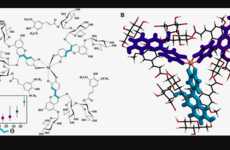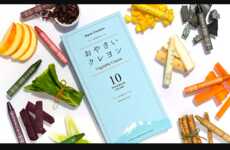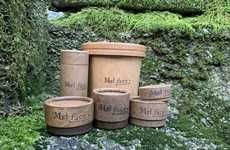'Kaiku' Creates Natural Pigments from Fruit & Vegetable Waste
Laura McQuarrie — September 4, 2019 — Eco
References: stjernsward.co & dezeen
Nicole Stjernsward developed Kaiku as a system that uses vaporization technology to create natural pigments from plants—including kitchen staples like Avocados, beetroots, pomegranates, citrus fruits and onions. Once processed, the pigments can be used as the raw material for dyes, inks and paints, especially as an alternative to artificial pigments that are commonly toxic. The system involves boiling the skins and peels of fruits and vegetables to produce a dye, which then passes through an atomizing nozzle and then a glass vacuum cleaner.
According to Stjernsward "Since many synthetic pigments today are toxic or made of ambiguous materials, color is typically considered a 'contamination' in the Circular Economy principles. I hope to change this paradigm."
Throughout history, brilliant pigments were derived from nature, making some much more precious and rare than others.
According to Stjernsward "Since many synthetic pigments today are toxic or made of ambiguous materials, color is typically considered a 'contamination' in the Circular Economy principles. I hope to change this paradigm."
Throughout history, brilliant pigments were derived from nature, making some much more precious and rare than others.
Trend Themes
1. Natural Pigment Production - Kaiku's vaporization technology offers a disruptive innovation opportunity for the production of natural pigments from fruit and vegetable waste.
2. Sustainable Dye Manufacturing - The development of Kaiku presents a disruptive innovation opportunity for the manufacturing of sustainable dyes, inks, and paints as an alternative to toxic artificial pigments.
3. Circular Economy Principles - Kaiku's system aligns with circular economy principles by utilizing fruit and vegetable waste to create natural pigments, challenging the perception that color is a 'contamination' in the industry.
Industry Implications
1. Textile and Fashion Industry - The textile and fashion industry can tap into Kaiku's natural pigment-making machines to produce sustainable dyes for fabrics, revolutionizing the way colors are applied to clothing.
2. Printing and Packaging Industry - The printing and packaging industry can benefit from Kaiku's innovative technology for creating natural inks, offering a more eco-friendly and non-toxic option for labeling and packaging materials.
3. Art and Design Industry - Kaiku's system presents an opportunity for the art and design industry to embrace sustainable and non-toxic paints, allowing artists and designers to create vibrant and safe works without compromising their health.
3.7
Score
Popularity
Activity
Freshness














